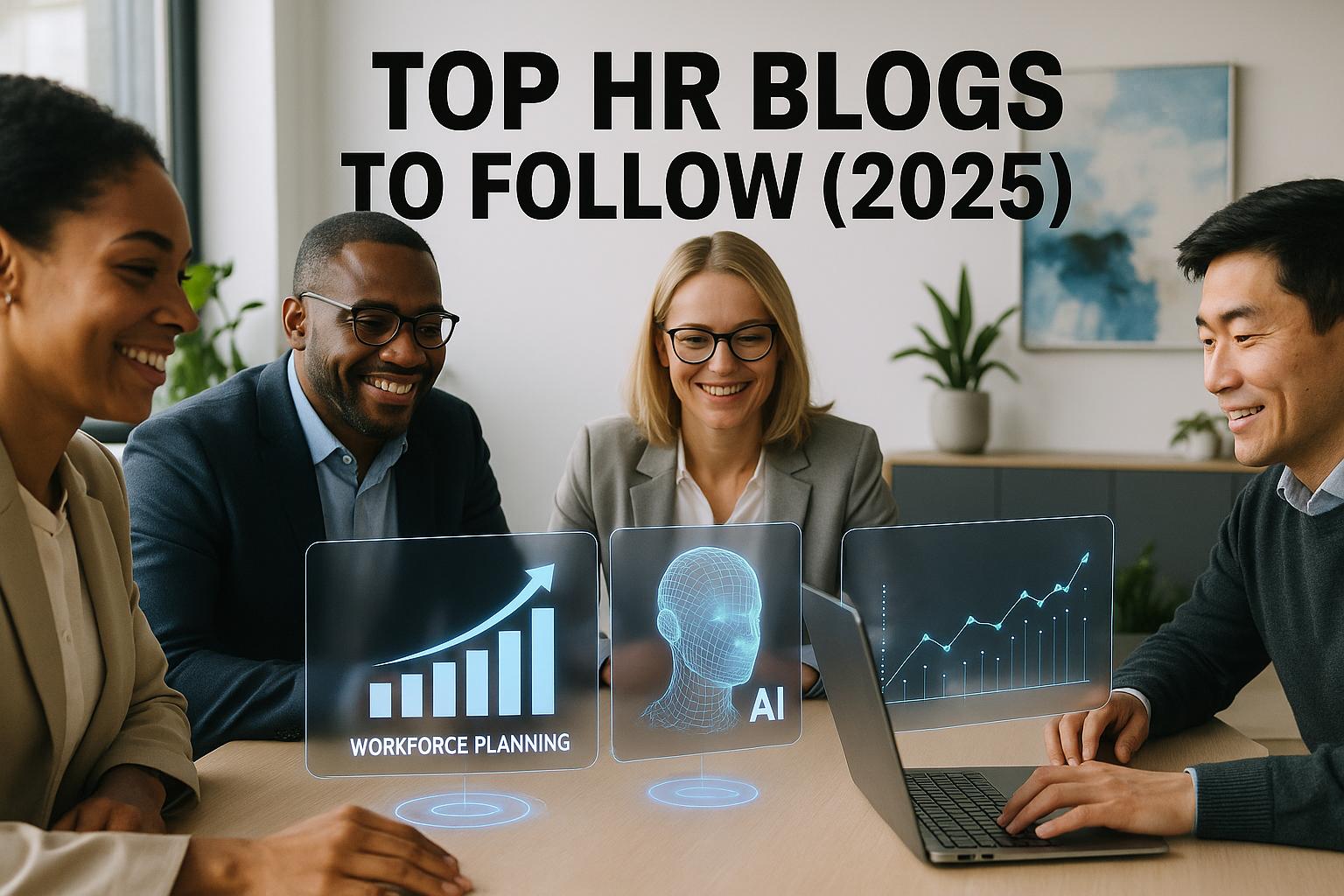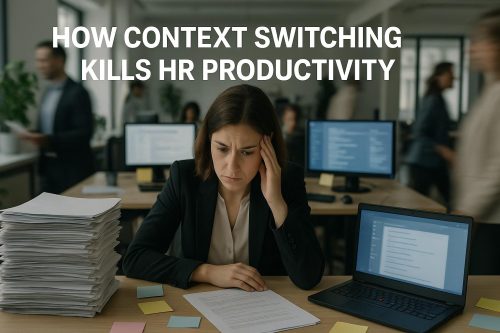Looking to stay ahead in HR? Here’s your shortcut to a list of top HR Blogs to Follow. These are the top Human Resources blogs that deliver actionable insights on AI, people analytics, employee engagement, and workforce planning. Whether you’re tackling skills gaps, digital transformation, or employee retention, these blogs provide clear strategies to help you navigate the ever-changing HR landscape.
Here’s a quick look at the top picks:
- AIHR Blog: Covers digital transformation, people analytics, and AI integration.
- HR Bartender: Practical advice on leadership, engagement, and compliance.
- Workology: Merges HR and tech with tools for leadership and AI-driven strategies.
- The Evil HR Lady: Honest, no-nonsense takes on workplace challenges.
- People Managing People: Expert-led advice on culture, engagement, and leadership.
- Shiftbase Blog: Data-driven tips for workforce planning and HR metrics.
Why follow these blogs? They tackle today’s pressing HR challenges and provide actionable solutions you can apply immediately. From AI tools to employee wellness strategies, these blogs are designed to keep you informed and prepared.
Ready to dive in? Let’s explore the details.
2025 Top 5 HR Trends Shaping Workplaces | Engage Blog
1. Davavo Blog
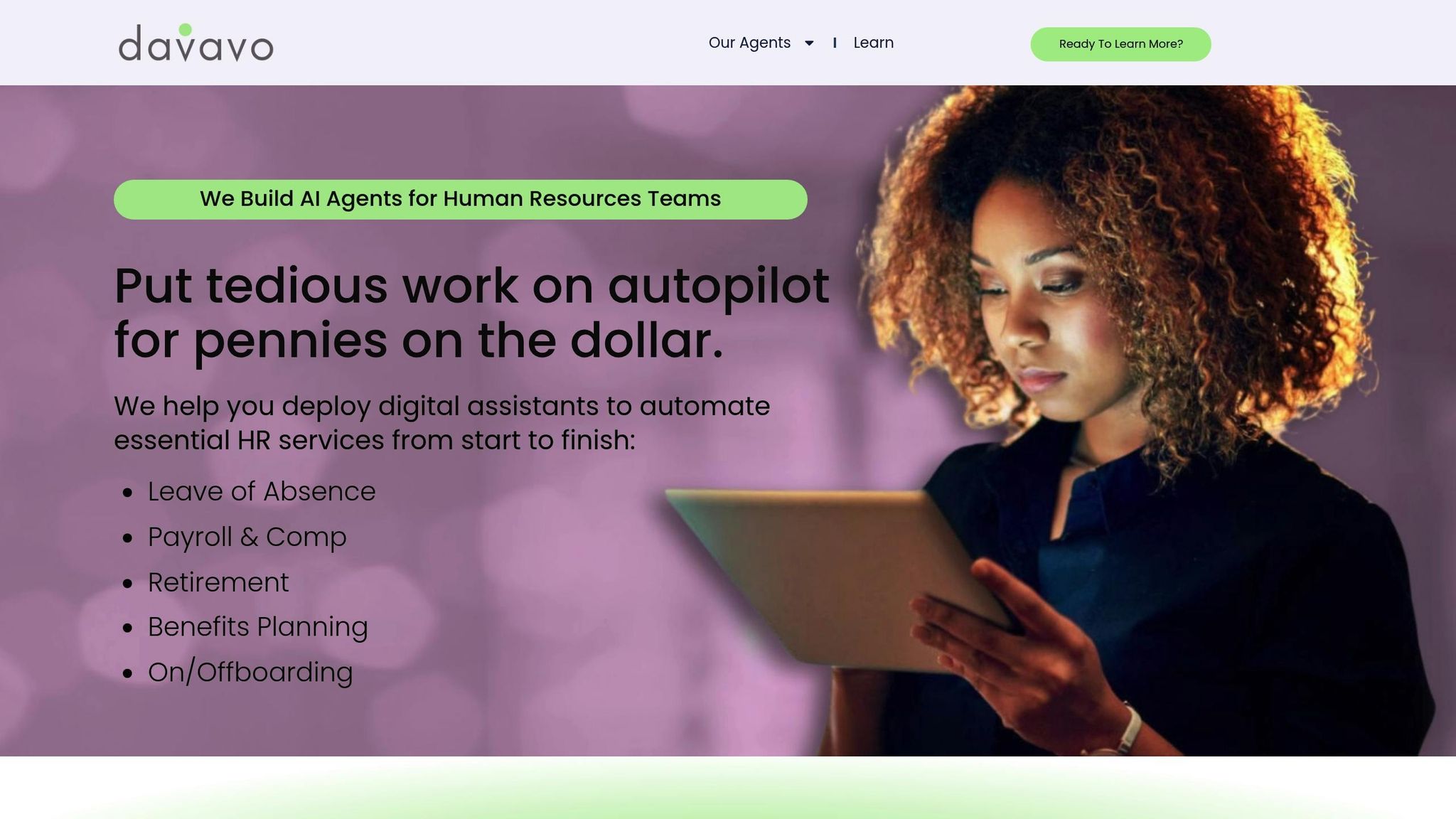
The Davavo Blog dives deep into the evolving world of HR technology and digital transformation, with a strong emphasis on how AI and automation are reshaping the workplace as we approach 2025.
By exploring topics like AI-driven HR automation, ethical hybrid work environments, and strategic workforce planning, the blog equips professionals with the tools they need to navigate a future where AI is expected to add $15.7 trillion to the global economy by 2030. It offers actionable advice, including:
- Strategic templates for integrating AI into HR processes
- Best practices for managing hybrid teams of humans and AI
- Ethical guidelines for deploying AI responsibly
- Performance evaluation frameworks tailored for AI-enhanced workplaces
These resources are designed to address the challenges HR professionals face as technology continues to evolve.
The blog also tackles the growing skills gap in the AI-driven workforce. With 76% of IT leaders reporting a critical shortage of AI-skilled talent, it provides strategies for upskilling employees and refining recruitment processes to meet the demands of an AI-enhanced workplace.
Additionally, it keeps readers informed about compliance and ethical concerns in digital HR. Topics like algorithm management, worker rights, and data privacy are regularly addressed, ensuring professionals stay updated on shifting standards. Through case studies and expert analysis, the blog showcases how industries like customer service, manufacturing, and healthcare are successfully implementing digital labor solutions. These insights empower HR professionals to stay ahead in a rapidly changing industry.
2. AIHR Blog

The AIHR Blog is a go-to source for insights on digital transformation and people analytics, offering HR professionals the tools they need to navigate the rapidly changing workplace. With new posts published three to four times a week, it keeps readers informed and prepared for the challenges ahead.
One of the key issues the blog tackles is the growing reliance on AI in the workplace. For instance, three out of four knowledge workers now use AI tools – often without adequate guidance. Meanwhile, only 41% of HR professionals feel equipped with the skills needed for digital transformation. The blog dives into these challenges, providing frameworks and actionable strategies to bridge the gap.
Its content falls into three main categories:
- Digital HR: Step-by-step guides and frameworks to help organizations navigate transformation effectively.
- People Analytics: Insights into a fast-growing market projected to reach $3.6 billion by 2028.
- AI Integration: Practical advice on deploying AI ethically and addressing bias concerns.
Expert perspectives add depth to the blog’s content. For example, Dr. Dieter Veldsman, Chief HR Scientist at AIHR, emphasizes the importance of aligning HR strategies with business goals:
"The HR strategy clarifies how HR will contribute to achieving the business objectives and helps to guide all HR activities." – Dr. Dieter Veldsman
The blog also explores workforce trends, such as the mismatch between current skills and future needs, women’s equity in the workplace, and the rise of “new-collar” jobs. Each article includes practical examples, visuals, and expert insights to help readers implement strategies effectively.
During times of economic uncertainty, AIHR’s content provides clear strategies to enhance employee engagement and performance. This focus reflects a growing trend, with over 70% of executives now prioritizing people analytics as a critical area of focus.
3. HR Bartender
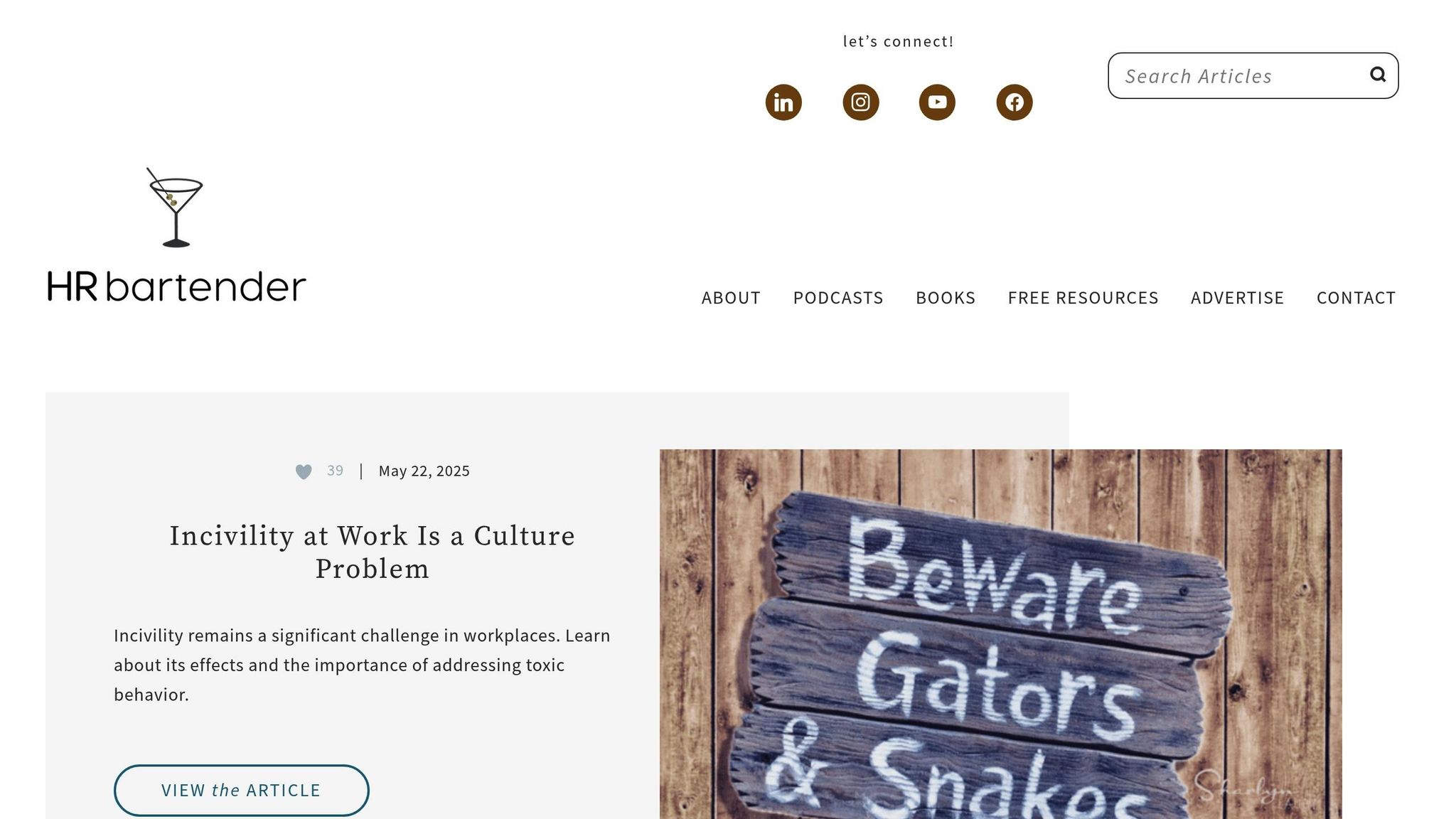
Launched in 2008 by HR expert Sharlyn Lauby, HR Bartender has earned recognition from SHRM as one of the top resources for straightforward, actionable HR advice. Its reputation stems from offering practical insights that tackle both long-standing and modern HR challenges.
The blog dives into key topics like business strategy, employee engagement, HR compliance, leadership development, workplace technology, and wellness. Lauby’s philosophy captures the blog’s friendly and accessible tone:
"I’ve always felt like my colleagues and employees wanted me to be like their neighborhood bartender – that friendly face who’s there when you need them."
True to this vision, HR Bartender provides clear guidance on issues like office politics, performance reviews, salary negotiations, and even tough conversations about terminations. This practical approach is especially relevant in a workplace where 94% of employees say they would stay longer with companies that prioritize their development.
What sets HR Bartender apart is its ability to connect organizational goals with individual growth. The blog offers strategies to enhance employee engagement and retention while addressing the latest workplace trends. It’s a go-to resource for HR professionals looking for a balance of expertise and approachability in navigating today’s evolving workplace dynamics.
4. Workology

Let’s dive into Workology, a blog that brings together the worlds of HR and technology in a way few others do. Created by Jessica Miller-Merrell, Workology attracts a massive audience of over 500,000 HR leaders every month.
This blog stands out by offering fresh perspectives on how HR professionals can embrace technology to improve their work. As Miller-Merrell explains:
"The future of HR isn’t about competing with machines – it’s about partnering with them. Let AI handle the repetitive stuff so you can focus on what you do best: solving complex problems, building great cultures, and connecting with people in real ways."
Workology tackles some of the most pressing challenges in HR by providing actionable content on topics like:
- Performance improvement strategies
- Leadership development tools
- AI-driven HR processes
- Strategic workforce planning
This blend of practical advice and forward-thinking ideas empowers HR professionals to make meaningful changes in their organizations. Keith M., Chief Marketing Officer at CareHive, highlights the impact of Miller-Merrell and her team:
"This is the second time I’ve worked with Jessica and her team. They are great to work with and have been an important part of our rebrand and content marketing strategy. She and her team show strength in doing the research and diving into a wide array of territory to create interesting work."
Beyond the blog, Workology offers a range of resources to help HR professionals level up their skills, including micro-courses starting at $99, HR certification preparation, and benchmark reporting services. These tools make it easier for professionals to put ideas into action.
With its practical focus and cutting-edge insights, Workology continues to be an essential resource for anyone navigating the evolving HR landscape.
5. The Evil HR Lady
Let’s dive into a resource that has built a reputation for delivering brutally honest insights into HR practices. Meet Suzanne Lucas and her blog, formerly known as "Evil HR Lady." In September 2024, Lucas rebranded her popular platform as "Improve Your HR" while keeping its signature straightforward, no-nonsense tone intact. With over a decade of HR experience, she has a knack for breaking down complex workplace issues into practical, candid advice.
What sets this blog apart is its bold approach to tackling workplace challenges, paired with an active Facebook community of more than 31,000 HR professionals. Lucas doesn’t shy away from calling out the flaws in HR practices, as she humorously puts it:
"Nobody likes their HR department. Let’s face it: There are lots of things that HR does that are super dumb."
This kind of frankness is what makes her content so impactful. Instead of sugarcoating or defending outdated methods, Lucas offers clear, actionable solutions to issues like workplace discrimination, payroll headaches, and poor candidate experiences. Her take on recruitment practices is refreshingly direct:
"One of my mantras is the way people hire. Organizations feel they should treat candidates poorly, and they do. This phenomenon of bringing people in for a third or fourth interview and then just ghosting them is global… It happens all the time, and it is bad PR."
The blog’s core mission is to explain the "why" behind HR decisions, shedding light on the complexities that often go unnoticed. As Lucas puts it:
"All HR people are evil, it’s in our job description. Or at least, that seems to be the prevailing theory. In reality, there’s just more going on behind the scenes than most people know. I’m here to demystify your Human Resources department and tell you just why you worked your tail end off all year and still got a 1.7 percent bonus."
sbb-itb-eb32bf3
6. People Managing People

People Managing People is a go-to platform for HR leaders looking for practical advice on organizational development and workforce management. Packed with articles, podcasts, and videos, it’s designed to provide busy professionals with quick, actionable insights. The variety of content formats ensures there’s always a resource handy to tackle different HR challenges.
The blog dives into key HR areas, including:
- Strategic workforce planning
- Leadership development
- Building company culture
- Employee engagement strategies
- Talent acquisition and retention
- HR software tools and systems
What sets this platform apart is its blend of expert-led discussions and real-world case studies. A weekly newsletter keeps readers informed about the latest industry trends. Plus, its active community creates a space for HR professionals to connect, exchange ideas, and learn from one another, making it more than just a content hub – it’s a networking opportunity. With updates several times a month, the blog stays fresh and relevant.
While the platform does feature a section on HR software solutions, its real strength lies in offering strategic insights rather than deep-dive technical reviews. The content is thoughtfully organized, making it simple to find solutions for recruitment, culture-building, or leadership challenges. Everything is presented in a way that’s clear and easy to implement, backed by industry expertise.
7. Shiftbase Blog
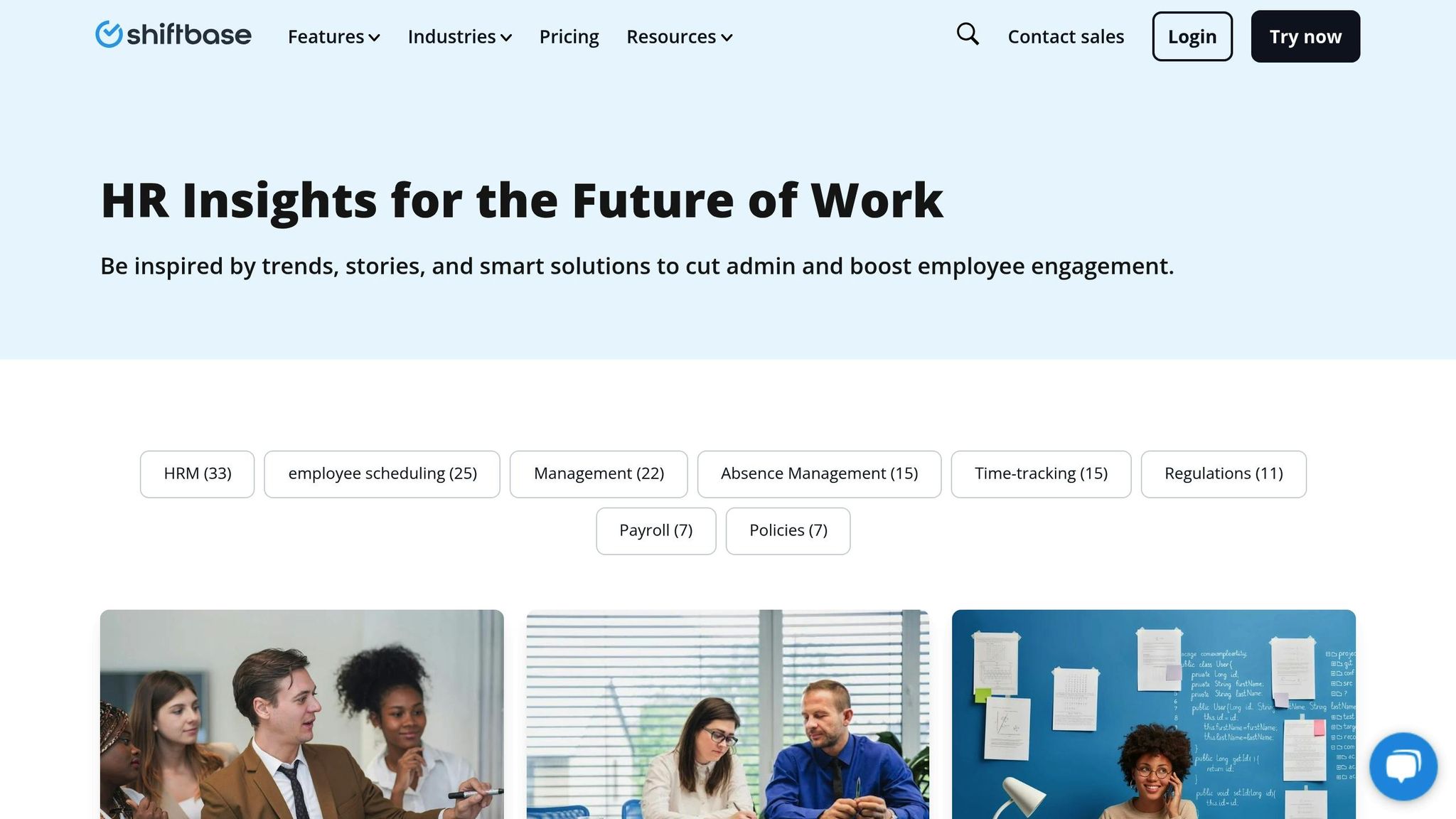
The Shiftbase Blog is a go-to resource for actionable advice on workforce management and HR metrics. With a strong emphasis on data-driven strategies, it provides HR professionals with tools and insights to improve employee management and drive organizational success.
This blog stands out by offering practical, real-time solutions that focus on three key areas essential for modern HR teams:
Workforce Planning & Analytics
Shiftbase offers strategic advice on workforce planning, helping HR teams align staffing needs with business goals. Articles delve into conducting skills assessments and implementing flexible work arrangements, which can enhance productivity and boost employee satisfaction.
Employee Engagement & Management
Employee engagement is a game-changer for organizations, leading to 22% higher profitability and 20% greater productivity. The blog shares proven techniques for fostering engagement, such as personalized career development plans and wellness initiatives.
HR Technology & Innovation
The blog highlights the role of technology in modern HR practices, covering topics like time tracking systems, automated scheduling, and integrating advanced HR tools.
"Shiftbase’s blog is a treasure trove for HR professionals, focusing on pivotal topics like HR metrics, employee management, and recruitment best practices." – Rinaily Bonifacio, Author
Beyond these core areas, the blog provides targeted strategies to tackle evolving workplace challenges, including:
- Streamlining recruitment processes with data-driven methods
- Implementing real-time feedback systems
- Designing effective training programs
- Ensuring compliance with labor laws
- Addressing the needs of a multigenerational workforce
- Adopting hybrid work models and flexible scheduling
What Makes These Blogs Different
What sets these blogs apart isn’t just their content – it’s their unwavering focus on actionable strategies and staying ahead of emerging trends. They tackle modern HR challenges head-on, offering insights that are well-researched and ready to implement.
Content That Goes Deeper
These blogs don’t just skim the surface. Instead, they dive into the core of HR issues, offering evidence-based strategies that simplify complex topics into practical solutions. For instance, 71% of executives emphasize the importance of employee engagement for organizational success. By addressing this with in-depth analysis and actionable steps, these blogs provide tools HR professionals can actually use.
Steady and Reliable Publishing
Consistency is key. Blogs that update two to six times a week see a 50% boost in positive outcomes and a 2.8% increase in content effectiveness. Whether it’s delivering data-driven insights, technical expertise, or real-world case studies, these blogs maintain a rhythm that keeps their audience informed and engaged.
Solutions You Can Apply Today
From advanced people analytics that have led to a 25% boost in productivity and halved employee attrition rates, to step-by-step advice on workplace strategies, these blogs prioritize actionable advice. They give organizations the tools to achieve measurable results in areas that matter most.
Spotlight on Emerging Trends
With 76% of job seekers weighing diversity heavily when evaluating potential employers, these blogs don’t shy away from critical issues. They cover topics like diversity, equity, and inclusion (DE&I), remote work strategies, employee wellness, digital transformation, and compliance updates. By addressing these trends comprehensively, they ensure HR professionals stay informed and prepared for what’s next.
These standout qualities not only underline the value of these blogs but also provide a roadmap for HR professionals looking to turn insights into impactful workplace strategies.
Tips for Using HR Blogs
Getting the most out of HR blogs isn’t just about bookmarking them for later. To truly benefit, you need a plan to turn the insights you gain into meaningful changes for your organization.
Create a Learning Schedule
Dedicate specific time each week to reading and learning from HR blogs. Regularly engaging with high-quality content can sharpen your decision-making skills. Try to schedule this during your most productive hours to maximize focus.
Focus on Relevant Content
Not every blog post will address your current priorities. Narrow your focus to articles that align with both your immediate challenges and long-term goals. For example, if boosting employee engagement is a priority, look for posts that share actionable strategies and proven outcomes. Once you’ve gathered these insights, organize them into clear, practical steps.
Turn Insights into Action
Here’s a simple way to translate what you learn into real results:
- Capture Key Takeaways: Create a digital notebook to jot down actionable points from blog posts.
- Share With Your Team: Pass along relevant articles to colleagues who can benefit.
- Plan Implementation: Use a structured approach – like a 30-60-90 day plan – to test and integrate new strategies effectively.
Use Technology to Your Advantage
With 41% of companies planning to increase their HR tech budgets, it’s important to explore how blog insights can enhance your current systems. Jenny Podewils, Co-Founder and Co-CEO at Leapsome, advises:
"It’s time to stop thinking of AI as a buzzword; focus on what key business challenges and priorities in a specific organization are. Then, dive into how AI tools can best help solve them via automation and augmentation".
By integrating these tools, you can automate processes and refine your HR strategies for better results.
Track Your Progress
Measure the impact of the strategies you adopt from blog recommendations. For instance, if you’ve launched a new employee wellness program inspired by a blog post, monitor metrics like satisfaction, engagement, and retention. Regular reviews will help you fine-tune your approach.
Stay Updated
Subscribe to newsletters from your favorite HR blogs to ensure you never miss valuable updates. As Marie Richter, Fractional Chief People Officer, puts it:
"By embracing these technologies to handle routine tasks, HR professionals can focus on what truly matters: strategy, employee experience, and driving organizational change. The ROI isn’t just financial; it’s reflected in increased employee potential".
Next Steps
Now that I’ve gathered actionable strategies from these HR blogs, it’s time to put them into practice and turn insights into tangible results.
Set Up Your Knowledge Hub
The first step is creating a centralized digital workspace where my team and I can organize and share insights from these blogs. As Dr. Dieter Veldsman, AIHR Chief Scientist for HR & OD, points out:
"Most HR strategies don’t fail when we write them – but during execution. As such, it is important to always do a sanity check during the HR strategy process. What will it take realistically to deliver this promise? How does this change what we do today? How will we capacitate the team to deliver? Strategies need to be aspirational, but also realistic in their ability to execute. I prefer to have a narrower focus on the things that matter, as opposed to trying to be everything to everyone."
This advice underscores the importance of staying realistic and focused while planning and implementing HR strategies.
Implement a Learning System
With 74% of companies planning to increase their HR tech budgets, setting aside dedicated time for continuous learning is essential. This ensures my team stays updated with fresh ideas that align with our current priorities.
Once the learning system is in place, I’ll measure its effectiveness to ensure it delivers real value.
Track Implementation Progress
To stay on track, I use a structured framework to monitor progress:
| Phase | Focus Area | Success Metrics |
|---|---|---|
| Discovery | Content Analysis | Weekly reading completion |
| Planning | Strategy Development | Action items identified |
| Execution | Implementation | Projects launched |
| Review | Impact Assessment | Measurable outcomes |
Sarah Chang, CEO of Clearwater HR Consulting, offers a valuable reminder:
"Don’t chase trends without understanding your unique business needs. Whether it’s a new tool, policy, or benefit, align every initiative with your organizational goals and employee priorities."
This reinforces the importance of tailoring every effort to the specific needs of the business and its people.
Leverage Technology
With the global HR tech market projected to reach $81.84 billion by 2032, I’ve started using AI-powered tools to handle routine tasks. These tools not only streamline operations but also enable more informed, data-driven HR decisions, making room for more strategic innovations within the team.
FAQs
How can HR professionals use AI to streamline their processes and focus on strategic goals?
HR teams can use AI to reshape their daily operations by automating time-consuming tasks such as data entry, scheduling, and managing documents. By doing so, they can reclaim 60-70% of the time typically spent on administrative work. This extra time can be redirected toward more meaningful activities like boosting employee engagement, creating development programs, and crafting retention strategies.
Another smart move is adopting Employee Self-Service (ESS) platforms. These tools let employees take charge of tasks like updating their personal details or accessing payroll information. This not only lightens the load for HR but also enhances employee satisfaction by giving them more control. Leveraging AI-powered solutions allows HR professionals to focus on impactful initiatives that contribute to an organization’s overall success.
What strategies does the AIHR Blog suggest for closing the skills gap during digital transformation?
The AIHR Blog outlines a few practical ways to tackle the skills gap during the digital transformation era. One of the first steps it suggests is conducting a skills gap analysis. This involves identifying the skills your workforce currently lacks and aligning them with the abilities needed to achieve your company’s future goals. It’s about spotting trends, understanding which skills are critical, and creating a clear action plan to address these gaps.
Another effective strategy is to focus on upskilling your existing employees instead of relying solely on external hires. By offering training and development opportunities, companies can nurture talent from within while also boosting employee morale and loyalty. These efforts not only help businesses stay competitive but also equip them to adapt more easily to the fast-changing demands of the digital age.
How does the HR Bartender Blog help HR professionals improve employee engagement and retention?
The HR Bartender Blog shares practical tips to boost employee engagement and retention by building a workplace culture that feels welcoming and supportive. It highlights the importance of open communication, trust, and making sure employees know their voices matter and their contributions are valued.
The blog dives into actionable strategies like holding purposeful one-on-one meetings, addressing obstacles that impact employee satisfaction, and creating a space where team members can grow both personally and professionally. These ideas equip HR professionals with the tools to design engagement initiatives that truly resonate with their teams.

